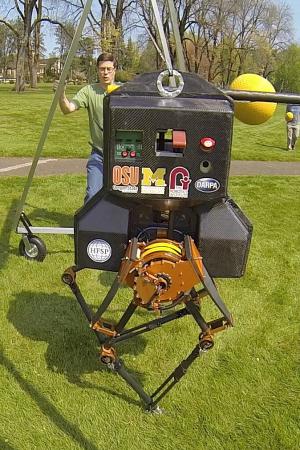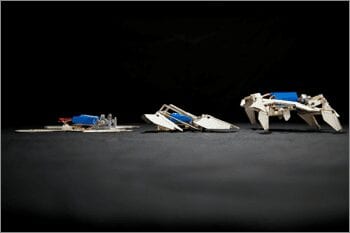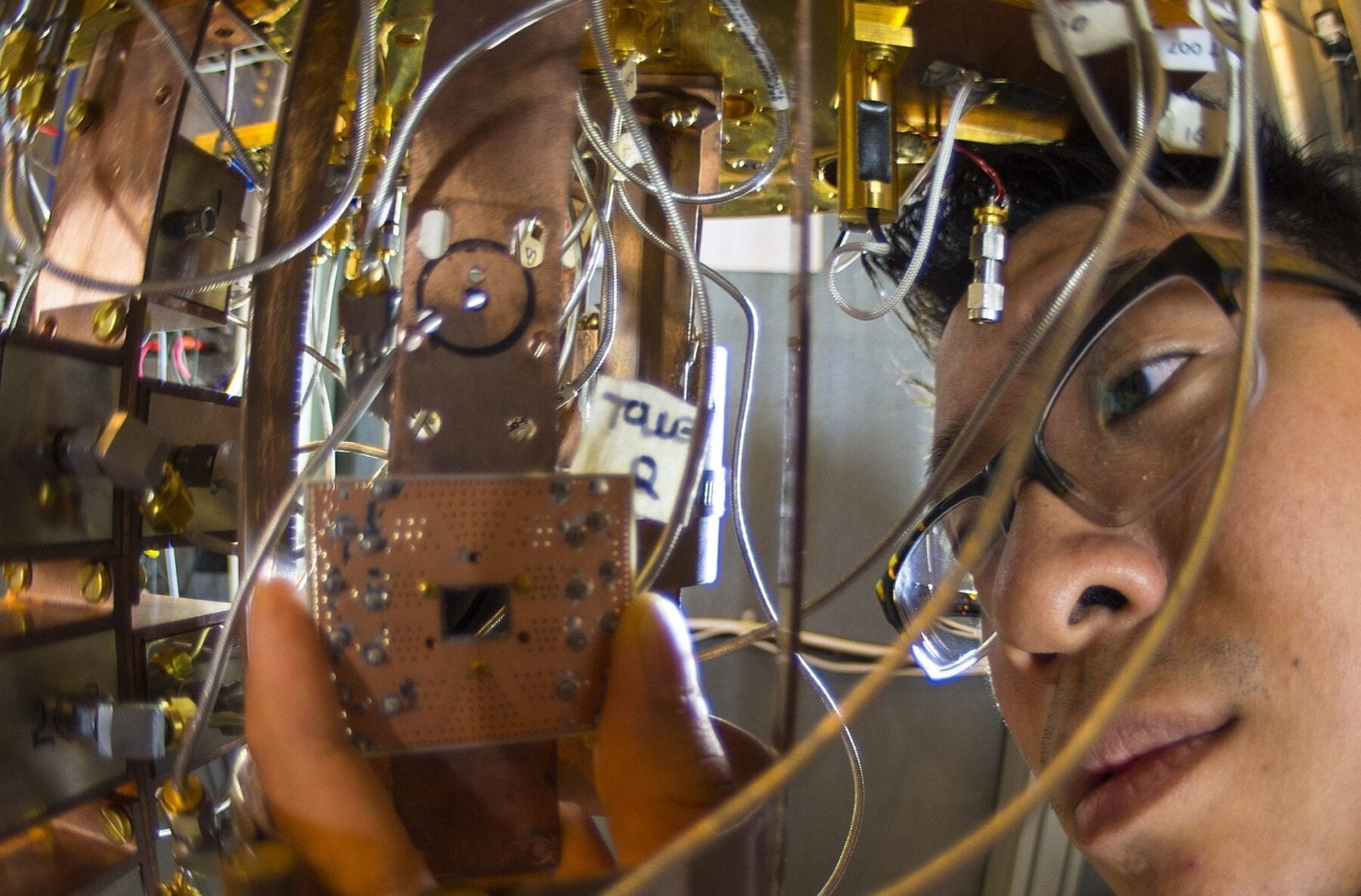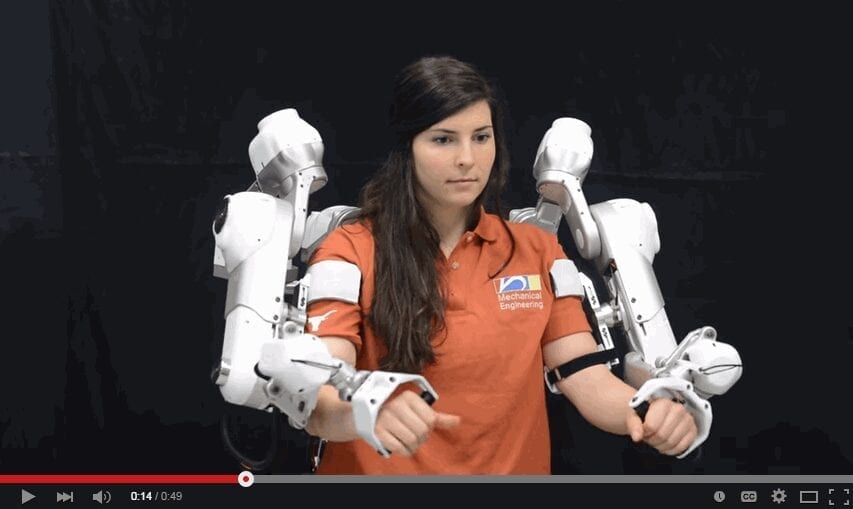
In a rolling, outdoor field, full of lumps, bumps and uneven terrain, researchers at Oregon State University last week successfully field-tested for the first time the locomotion abilities of a two-legged robot with technology that they believe heralds the running robots of the future.
The test demonstrated how their “ATRIAS” robot can move quite nicely, keep its balance and withstand mild blows from a bouncing rubber ball, while taking a walk in the grass, up and down hill, and over varying terrain at a normal walking speed of a little more than three miles per hour.
A video demonstration is available at http://bit.ly/1HQKqOZ
As a bipedal robot that was biologically inspired to mimic the spring-legged action of animals, the researchers said this is the closest a machine has yet come to resembling human locomotion.
The human-sized robot had six electric motors powered by a lithium polymer battery about the size of a half-gallon of milk, which is substantially smaller than the power packs of some other mobile robots. This is made possible by the energy efficiency of its elastic leg design and the energy retention that’s natural to animal movement.
“Animals with legs sort of flow in the energy used, in which retained kinetic energy is just nudged by very efficient muscles and tendons to continue the movement once it has begun,” said Jonathan Hurst, an Oregon State associate professor of mechanical engineering, and director of the Dynamic Robotics Laboratory in the OSU College of Engineering.
“That’s part of what’s unique about ATRIAS – not just that it can walk, and will eventually run – but that it’s doing so with animal-inspired fluidity of motion that is so efficient,” Hurst said. “This will ultimately allow a much wider range of robotic uses and potential than something which requires larger amounts of energy.”
In these tests, the robot was tethered to a safety harness on a supporting frame that rolled along with it – not to supply energy or aid in walking, but just to help catch it if it fell, which it did a couple times due to sensor glitches. The goal was to prevent costly damage during the research and development.
“It already appears that ATRIAS is three times more energy-efficient than any other human-sized bipedal robots,” said Christian Hubicki, an OSU postdoctoral scholar working with Hurst. “And this was the first time we’ve been able to show its abilities outside, in a far more challenging environment than anything in a laboratory.
“This is part of a continuous march toward running robots that are going to be useful and practical in the real world.”
Read more: Inspired by humans, a robot takes a walk in the grass
The Latest on: Running robot
[google_news title=”” keyword=”Running robot” num_posts=”10″ blurb_length=”0″ show_thumb=”left”]
via Google News
The Latest on: Running robot
- America Can’t Stop Watching Creepy Robot Videoson May 1, 2024 at 1:12 pm
Boston Dynamics has perfected the art of freaking people out. Now other tech companies are trying to do the same.
- InOrbit introduces RobOps Copilot for mobile robot fleet insightson May 1, 2024 at 6:01 am
InOrbit says this new product will provide actionable robot operations and fleet insights to anyone, regardless of technical expertise.
- InOrbit Launches RobOps Copilot for AI-Powered Robot Fleetson April 30, 2024 at 5:00 pm
In the early days of robotics – primarily in the automotive industry – each robot pretty much required a dedicated programmer. Needless to say, this added significantly to the cost of robotics. Over ...
- Best deals on robot vacuums ahead of Memorial Dayon April 30, 2024 at 12:33 pm
It's time for a thorough house cleaning this spring, and a robot vacuum can help you do all the heavy lifting.
- MIT Technology Reviewon April 30, 2024 at 4:15 am
AI is upending the way robots learn, leaving companies and researchers with a need for more data. Getting it means wrestling with a host of ethical and legal questions.
- AI Faces Its ‘Oppenheimer Moment’ During Killer Robot Arms Raceon April 29, 2024 at 3:44 pm
Regulators who want to get a grip on an emerging generation of artificially intelligent killing machines may not have much time left to do so, governments were warned on Monday.
- This is the first humanoid electric robot that can run at 6km/hon April 29, 2024 at 4:34 am
The Beijing Humanoid Robot Innovation Center launched its electric humanoid robot “Tiangong” on Saturday. My Drivers, via Kuai Technology, reported that the launch took place in the Beijing Economic ...
- Humanoid robots are learning to fall wellon April 28, 2024 at 1:15 pm
The savvy marketers at Boston Dynamics produced two major robotics news cycles last week. As I write this, the sub-40 second video is steadily approaching five million views. The accompanying video ...
- China unveils “Tiangong”: First fully electric humanoid robot capable of running at 6 km/hon April 27, 2024 at 5:10 am
China's Beijing Humanoid Robot Innovation Center unveils "Tiangong," a robot capable of human-like running at 6 km/h.
- Why animals run faster than their robot doppelgängers… for nowon April 24, 2024 at 11:00 am
“It [advances in robots] will move faster, because evolution is undirected,” University of Washington Department of Electrical & Computer Engineering Associate Professor Sam Burden said. “There are ...
via Bing News










